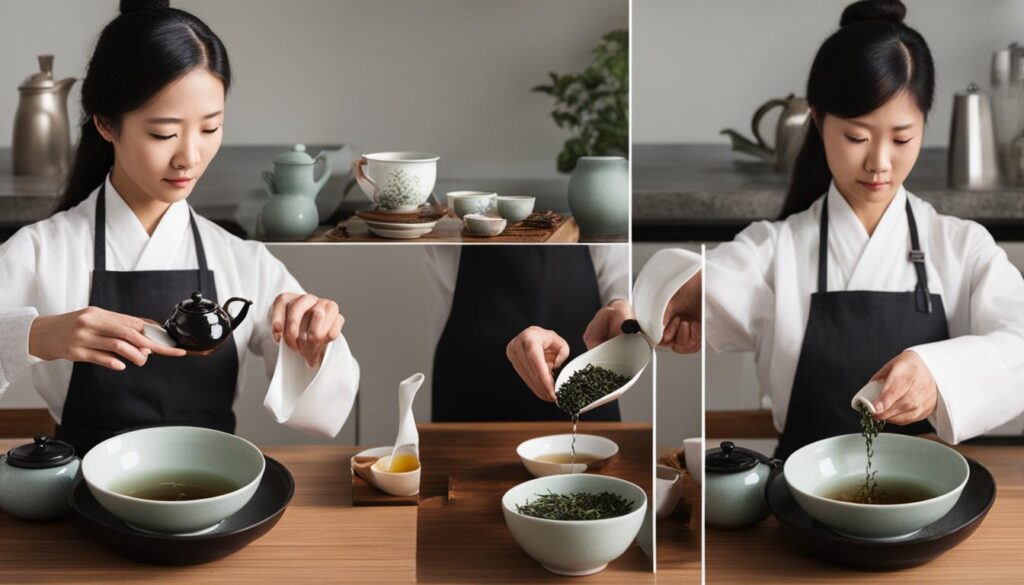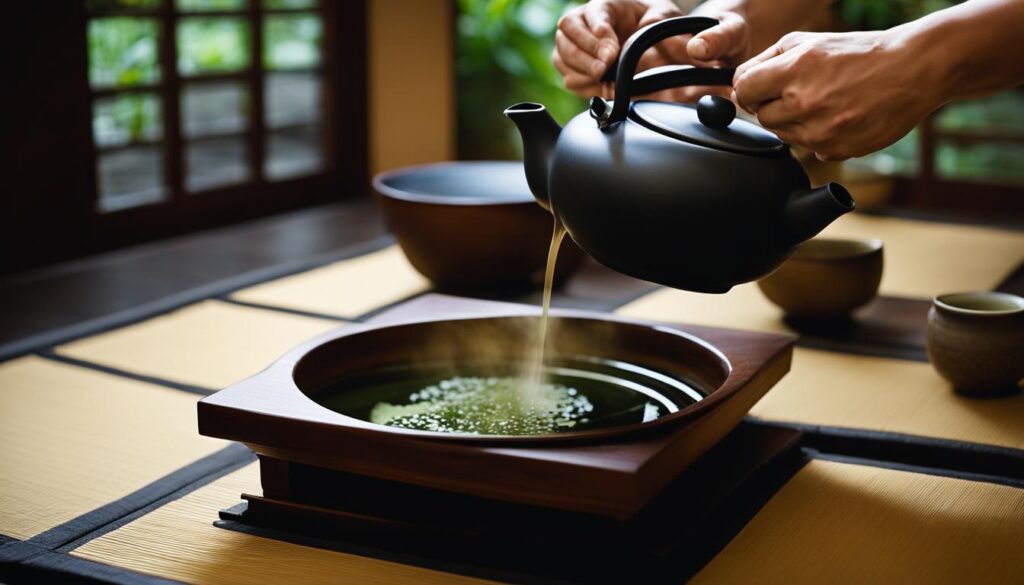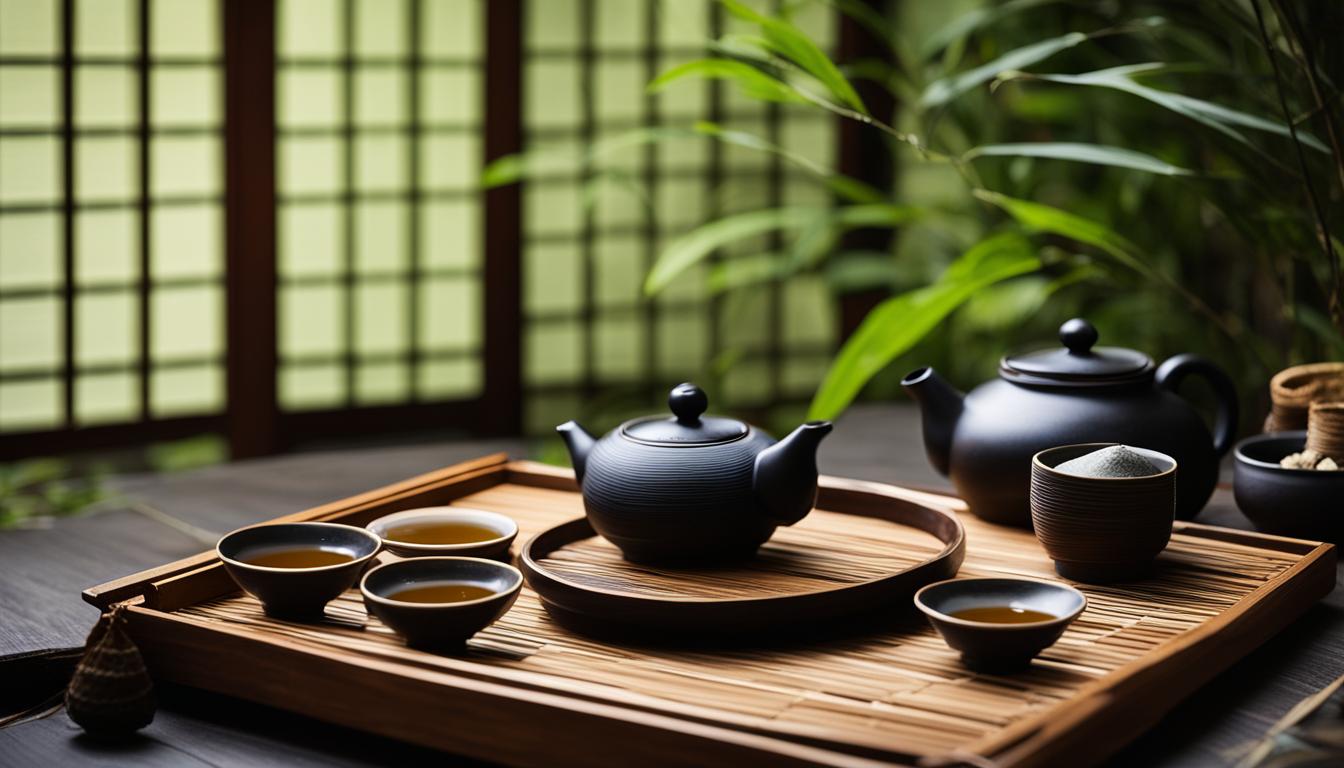Tea ceremonies are an enchanting way to experience the art and beauty of preparing tea. In this article, we will explore the rich traditions and rituals behind these ceremonies, from the leaf to the cup. From the serene Japanese tea ceremony to the elegant Chinese tea ceremony, we will delve into the fascinating world of tea preparation and discover the secrets to achieving the perfect cup of tea.
Key Takeaways
- The Chinese tea ceremony is known for its meticulous and beautiful preparations.
- Tea ceremonies involve the use of various tools and accessories, such as teapots and teacups.
- The Eastern and Western methods of tea preparation have their own unique characteristics and benefits.
- Tea ceremonies have a long and rich history, influenced by different philosophies and traditions.
- Tea ceremonies are not exclusive to China and Japan; they have spread to various countries around the world, each with its own distinct customs and rituals.
The Art of Tea Preparation: Eastern vs. Western Methods
When it comes to the art of tea preparation, there are two distinct methods: Eastern and Western. Each method has its own unique techniques and approaches, ensuring that tea is brewed and enjoyed in the most optimal way possible.
Eastern Method: The Eastern method, which originated in China, is known for its meticulous attention to detail and its focus on achieving the perfect balance of flavors and aromas. In this method, a large quantity of tea leaves is used, allowing for shorter steeping times and multiple extractions. This technique allows the tea leaves to gradually release their essence, resulting in a more delicate and nuanced brew. It is often preferred for delicate teas such as green teas and oolongs.
Western Method: The Western method, commonly practiced in Anglo-Saxon countries, takes a slightly different approach. It involves using a smaller quantity of tea leaves, longer steeping times, and only a single extraction. This method is suitable for teas that require a longer brewing time to fully develop their flavors, such as black teas and some herbal infusions. The result is a bolder and more robust cup of tea.
Eastern method focuses on short steeping times and multiple extractions, while Western method favors longer steeping times and single extraction.
The choice between the Eastern and Western methods ultimately depends on personal preferences and the type of tea being prepared. Some tea enthusiasts may prefer the delicacy and complexity of the Eastern method, while others may opt for the boldness and simplicity of the Western method.
Whichever method you choose, exploring the art of tea preparation allows you to fully appreciate the intricacies and nuances of this beloved beverage. So, whether you’re savoring a delicate green tea or indulging in a robust black tea, remember that the journey from leaf to cup is a carefully crafted process that enhances the flavors and experiences of tea. Happy brewing!
Table: A Comparison of Eastern and Western Tea Preparation Methods
| Aspect | Eastern Method | Western Method |
|---|---|---|
| Tea Leaf Quantity | Large quantity | Small quantity |
| Steeping Time | Short | Long |
| Extractions | Multiple | Single |
| Tea Types | Green, oolong, delicate teas | Black, herbal infusions |
| Result | Delicate, nuanced flavors | Bold, robust flavors |

As you can see from the table above, there are notable differences between the Eastern and Western methods of tea preparation. The Eastern method focuses on shorter steeping times and multiple extractions, allowing for a more delicate and nuanced flavor profile. On the other hand, the Western method uses longer steeping times and a single extraction, resulting in a bolder and more robust cup of tea.
By understanding the various techniques and approaches to tea preparation, you can enhance your tea-drinking experience and discover new flavors and sensations. So, whether you choose to embark on the Eastern path or opt for the Western route, the art of tea preparation promises a journey of exploration and enjoyment.
The Rich History of Tea Ceremonies
The rich history of tea ceremonies dates back to ancient times, originating in China where tea was first cultivated. The Chinese tea ceremony, deeply rooted in philosophy and spirituality, embodies the principles of harmony, respect, and balance. It is influenced by various philosophies, such as Confucianism, Buddhism, and Taoism, and serves as a medium to achieve inner peace and a connection to nature.
When it comes to Chinese tea ceremonies, the choice of tea is of utmost importance. Different types of tea, such as green, oolong, black, or Pu-erh, are selected based on the occasion and personal preferences. The ceremony also emphasizes the quality of water used, which should be pure and free from impurities that could alter the taste of the tea. Temperature control plays a crucial role in the brewing process, as each type of tea requires a specific temperature to bring out its best flavors and aromas.
The preparation steps of a Chinese tea ceremony are steeped in tradition and can vary depending on the tea master’s preferences and the specific ceremony being performed. These steps may include rinsing the teaware, warming the teapot, measuring and adding the tea leaves, pouring the water, and serving the tea with grace and mindfulness. Each gesture and movement is carefully executed to create a harmonious and serene experience for both the host and the guests.

Tea Ceremonies in Japan: A Cultural Treasure
In Japan, tea ceremonies hold a special place in the country’s cultural heritage. Known as chanoyu or sadō, the Japanese tea ceremony is a highly ritualistic practice that embraces simplicity, mindfulness, and harmony. Matcha, a powdered green tea, takes center stage in these ceremonies.
The choice of tea for a Japanese tea ceremony is typically the high-grade matcha, carefully whisked with hot water to create a vibrant and frothy beverage. The preparation follows a precise sequence of movements, with great emphasis on cleanliness, respect, and attention to detail. Japanese tea ceremonies often take place in dedicated tea rooms, which are designed to create a serene and tranquil environment for the participants.
Both the Chinese and Japanese tea ceremonies offer a profound appreciation for tea and the artistry involved in its preparation. They provide a glimpse into the rich cultural heritage of the respective countries and serve as a reminder to slow down, find peace in the present moment, and savor the simple pleasures that tea brings.
Tea Ceremonies Around the World
Tea ceremonies are not limited to China and Japan; they have made their way to various countries, each with its own unique traditions and customs. Let’s explore some of these fascinating tea ceremonies from around the world.
Masala Chai in India
In India, masala chai is a popular tea preparation that combines black tea with a mixture of aromatic spices and milk. This flavorful and fragrant tea is a staple in Indian households and is enjoyed throughout the day. The spices used in masala chai can vary, but commonly include ginger, cardamom, cinnamon, cloves, and pepper. The tea is brewed with these spices along with milk and sweetened to taste. Masala chai is not just a beverage; it is a cultural symbol of hospitality and warmth in Indian society.
Russian Samovar Tradition
In Russia, tea holds a special place in their culture, and the samovar is an essential part of their tea tradition. A samovar is a metal container used to heat and boil water for tea. It is often beautifully decorated and serves as a centerpiece during tea ceremonies. In Russian tea culture, the tea is typically strong and brewed for a long time, resulting in a rich and robust flavor. Tea is served in a small teacup called a “podstakannik” and is accompanied by traditional Russian pastries, such as “pirozhki” (small savory pastries) or “blini” (thin pancakes).
Mint Tea in Morocco
In Morocco, mint tea, also known as “Moroccan tea” or “Maghrebi mint tea,” is an integral part of their hospitality and social customs. This refreshing tea is made by steeping green tea leaves with fresh mint leaves and sweetening it with sugar. The tea is poured in a long pour from a silver teapot into small glasses, held high above the cups to create a frothy layer. Mint tea is often served with pine nuts or almonds and accompanied by sweet treats like dates or pastries. Sharing mint tea is a symbol of friendship and hospitality in Moroccan culture.
Butter Tea in Tibet and Nepal
In the mountainous regions of Tibet and Nepal, butter tea, also known as “po cha” or “suja,” is a traditional beverage enjoyed by the locals. Butter tea is made by churning tea leaves with yak butter, salt, and sometimes spices like ginger or cardamom. The resulting concoction is a rich, creamy, and fortifying tea that provides warmth and sustenance in the cold Himalayan climate. Butter tea is often served in small bowls and is a significant part of social gatherings and religious ceremonies in these regions.
Conclusion
As we conclude our journey through the world of tea ceremonies, we are reminded of the incredible brewing techniques that bring out the true essence of tea. From the intricate water quality considerations to the careful selection of tea leaves, every step in preparing tea for ceremonies is a testament to the artistry and dedication of tea enthusiasts.
Temperature control plays a crucial role in achieving the perfect cup of tea during these ceremonies. The balance of heat and steeping time creates a harmonious blend of flavors that tantalizes the taste buds. Whether it’s the vibrant and aromatic Chinese ceremonies or the serene and tranquil Japanese traditions, each tea ceremony has its own unique temperature control methods that contribute to its distinctive character.
Tea grinding is also an essential aspect of these ceremonies, as it ensures the proper release of flavors and aromas. The grinding process varies depending on the type of tea and the desired level of fineness. The careful attention to this detail ensures that every sip of tea is a delightful experience.
Finally, let’s not forget the importance of choosing the right tea for Chinese ceremonies. The art of tea selection requires an understanding of the flavors, aromas, and characteristics of various tea varieties. From delicate green teas to robust black teas, the choice of tea adds depth and complexity to the ceremonial experience.
FAQ
What is a tea ceremony?
A tea ceremony is a traditional way of preparing and enjoying tea, often characterized by ritualistic and beautiful preparations.
How popular are tea ceremonies in the US and Europe?
Tea ceremonies are gaining popularity in the US and Europe as people become more interested in the art and culture of tea.
What is the Chinese tea ceremony known for?
The Chinese tea ceremony is known for its ritualistic and beautiful preparations, aiming to achieve the best taste of tea and a harmonious moment in space and time.
What tools and accessories are used in a tea ceremony?
A tea ceremony involves the use of various tools and accessories, such as a tea boat, teapot, and teacups. The choice of these tools depends on individual preferences and the type of tea being prepared.
What are the two main methods of tea preparation?
The two main methods of tea preparation are the Eastern method, which originated in China, and the Western method, commonly practiced in Anglo-Saxon countries.
How does the Eastern method of tea preparation differ from the Western method?
The Eastern method involves using many tea leaves, short steeping times, and multiple extractions, while the Western method uses fewer tea leaves, longer steeping times, and a single extraction.
What influences the Chinese tea ceremony?
The Chinese tea ceremony is influenced by various philosophies, such as Confucianism, Buddhism, and Taoism.
What are the core elements of the Chinese tea ceremony?
The Chinese tea ceremony focuses on achieving harmony and perfection through the interplay of the five core elements: wood, fire, earth, metal, and water.
Do other countries have their own tea ceremonies?
Yes, tea ceremonies have spread to various countries around the world, each with its own unique traditions and customs.
What are some examples of tea ceremonies in different cultures?
In India, masala chai is a popular tea preparation, while in Russia, the samovar is used for tea brewing. Morocco is known for its mint tea, and Tibet and Nepal have their own unique tradition of butter tea.
How can one appreciate the beauty of tea ceremonies?
By immersing oneself in the rituals and traditions of tea ceremonies, one can truly appreciate the depth and complexity of this ancient beverage.





